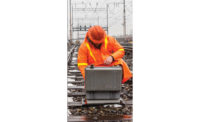Railroads are making modest gains in meeting a federally mandated year-end 2018 deadline for installing technology to prevent collisions and derailments, the Federal Railroad Administration says. Carriers’ progress toward the positive train control (PTC) systems goal also varies widely, the agency says.
FRA’s latest PTC update, released on Nov. 28, shows that freight railroads had the technology active on 12% of their route miles as of Sept. 30, up from 9% for the previous quarter. FRA also said passenger railroads, including commuter-rail lines, had equipped 23% of their mileage with PTC, an uptick from 22% in the second quarter.
FRA also charted progress toward several other PTC goals, including the percentage of locomotives with the needed equipment installed, the number of radio towers in place and the number of employees who have completed PTC training.
Among major freight railroads, BNSF was furthest along in the share of miles with PTC in operation, at 34%. CSX was at 25%, and Norfolk Southern and Union Pacific each had no miles with active PTC.
Ed Greenberg, a spokesman for the Association of American Railroads, said via email, "Implementing this developed-from-scratch technology remains a priority for the nation’s freight rail industry, with Class 1 freight railroads remaining on track at having PTC fully installed by the deadline."
Greenberg added, "The reality is that this revolutionary technology is not 'off the shelf.' It had to be developed from scratch and isn’t just about plugging in or turning on components. It is a complex, step-by-step process … in terms of safety, engineering and implementation."
In the passenger-rail sector, FRA said Amtrak had active PTC service on 67% of 898 route miles, the same percentage as in the previous quarter. The 898-mile total includes freight railroad-owned lines over which Amtrak operates service. Those freight carriers are responsible for PTC installation on the route miles they own.
Amtrak had activated, in December 2015, PTC on all but seven miles of the 363 miles that it owns on the Northeast Corridor. The exceptions are in or near terminals, where other train control systems operate, a spokesperson said.
The Amtrak spokesperson also said the railroad completed PTC implementation on its Harrisburg, Pa., line earlier this year.
Among commuter-rail carriers, the Southern California Regional Rail Authority had PTC operational on 99% of its 249-mile network, the same as its second-quarter percentage, and the Southeastern Pennsylvania Transportation Authority had the technology in place on 73% of its 108 route miles as of Sept. 30, up from 34% in the second quarter.
But others lagged, according to FRA data. The busy New Jersey Transit and New York Metropolitan Transportation Authority's Metro North and Long Island Rail Road (LIRR) systems had no fully active PTC on any route miles, FRA said.
But MTA says it has made significant PTC progress on its commuter lines. The authority is benefitting from a $967.1-million FRA loan, on which the agency closed in May 2015, to assist in deploying the technology on Metro North and LIRR.
In a statement provided to ENR, MTA Chairman Thomas Prendergast said, “Metro North and LIRR have aggressively and diligently moved forward to fully implement PTC on both railroads before the congressionally mandated deadline of 2018.”
In 2015, MTA awarded a $428.5-million contract to a joint venture of Siemens and Bombardier for PTC installation on Metro North east of the Hudson River and the LIRR.
In a presentation to its Capital Program Oversight Committee on Oct. 26, MTA reported that it was “on schedule” to meet the 2018 target. The agency said it had spent $279 million, or 29% of the project’s $968-million estimated cost.
MTA also reported that there has been delay in the overall system design process and said that, to save time, it will carry out software and hardware designs along parallel schedules, instead of sequentially.
PTC systems include a combination of on-board and wayside equipment.
In 2008, Congress mandated PTC implementation on most of the nation’s rail network by Dec. 31, 2015. But as it became clear that most railroads wouldn’t meet the deadline, Congress passed, in 2015, and President Obama signed legislation providing a three-year extension. Carriers also can seek a waiver to have up to an additional two years to complete PTC work.
For many years, the National Transportation Safety Board has called for PTC use.
After investigating a May 2015 Amtrak derailment in Philadelphia that killed eight passengers, the NTSB determined that the accident’s probable cause was the engineer’s being distracted, resulting in excessive train speed. But the board also said a contributing factor was that PTC technology, though installed in the crash area, wasn’t operational there at the time of the accident.
Story updated on Nov. 30 to clarify statistics on Amtrak route miles.



Post a comment to this article
Report Abusive Comment